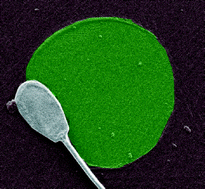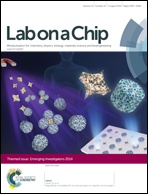Make it spin: individual trapping of sperm for analysis and recovery using micro-contact printing†
Abstract
In this article, we describe the development of a high throughput platform to spatially manipulate viable sperm for motility measurements and recovery of the best single sperm for fertilization purposes. Micro-contact printing was used to pattern islands of adhesive proteins (fibronectin) separated by sperm repellent species (Pluronic acid F-127) on commercially available polystyrene substrates. Following washing, arrays of viable single sperm were captured onto the islands demonstrating for the first time that sperm can be trapped by micro-contact printing with patterning efficiency of 90% while retaining 100% viability. These were then subjected to motility analysis whilst remaining spatially confined to the islands. Single sperm motility was assessed (n = 37) by software analysis measuring the number of rotations per second (degrees s−1). The assignment of array coordinates allows the more active single sperm to be easily identified and recovered by a simple micromanipulator pipette aspiration step with automated possibility for assisted reproductive technologies or further quality correlation analysis. Taken together, we show for the first time a technique to simultaneously screen thousands of viable single sperm for motility assessment while retaining the ability for single species recovery for enhanced fertilization purposes.

- This article is part of the themed collection: 2014 Lab on a Chip Emerging Investigators

 Please wait while we load your content...
Please wait while we load your content...